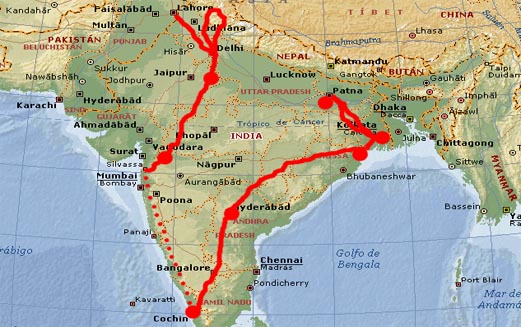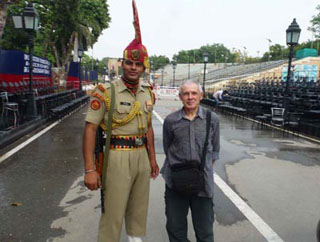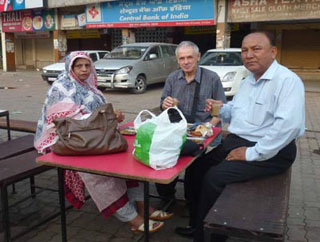| |
estar prohibido cualquier tipo de discriminación social, la casta de los intocables sigue siendo
una lacra en algunas zonas rurales del País.
El 11 de Mayo entro en la
India por Amristar con la compañía de Nassen y su mujer. Nos quedamos a
ver la famosa representación de clausura del puesto fronterizo que se
celebra
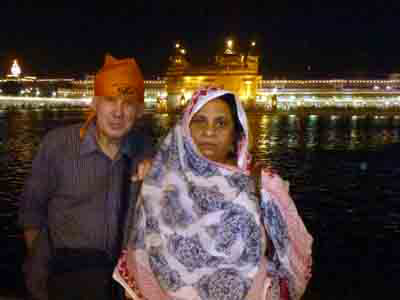
todos los dias conjuntamente entre los guardias Indios y
Pakistaníes, y es curioso verlos hacer sus artísticas maniobras
compitiendo entre ellos. La verdad es impresionante observarlos con su
altura de 1,90 m y más, y su elegante porte.
Ya al anochecer llegamos a Amristar con la parada obligatoria en el
Templo de Oro, el lugar más sagrado de los Siks, pero al que acuden
gentes de todos los rincones de la India: está abierto las |
|
24 horas del día y sus monjes entonan sus canciones
sin parar.
El 12 de Mayo llego a Delhi donde tengo que extremar las
precauciones pues la conducción, como en general en toda la India, es
bastante complicada. Los camioneros son un auténtico peligro público que
no respetan nada ni a nadie: adelantan cuando les viene en gana y
literalmente te sacan de la carretera. Nassen y su mujer se van a casa
de un amigo Indio y yo busco un lugar para dormir: el calor dentro de
Ibiletxe es insoportable por lo que al día siguiente decido buscarme un
hostel.
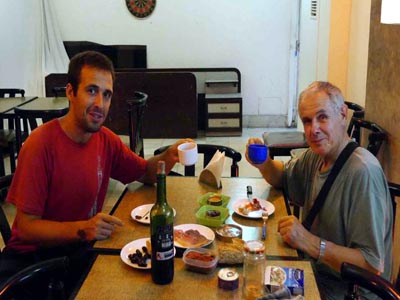
Y el 14 de Mayo se produce un bonito encuentro: Lander, un ciclista
de Tolosa que salio pedaleando desde Euskalerria hace más de un año,
llega al mismo hostel donde previamente habíamos quedado. Se antojaba
complicado que coincidiésemos, |
|
pero la magia de estos viajes puede hacer que el
mundo se haga lo suficientemente pequeño para que dos viajeros se
encuentren. Y dos días mas tarde viene la celebración: jamón, queso,
vino, chorizo que Ibiletxe gentilmente ha transportado para este
momento, y para postre la llamada de Aitor desde Euskalerria Irratia,
radio euskadi, para hacernos una pequeña
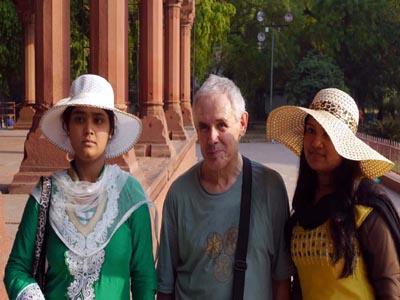
En el fuerte Mogol de Delhi
entrevista.
Mientras
estoy en Delhi intento conseguir el permiso de la embajada de Myanmar
para ir a través de este país desde India a Thailandia, y aunque mi
solicitud mandada hace 4 meses la han tenido en cuenta, ahí se queda
todo. El país ha estado cerrado para vehículos pero últimamente parece
que están abriendo la |
|
|
| |
mano,
aunque de una forma bastante aleatoria y con cuentagotas. Tal vez si me
hubiese quedado mas tiempo en Delhi lo podría haber conseguido, pero
hace mucho calor y tengo ganas de aire fresco, por lo que el 18 de Mayo
Lander y yo nos vamos hacia el norte. Esa noche llegamos a Rishikesh,
al día siguiente Lander
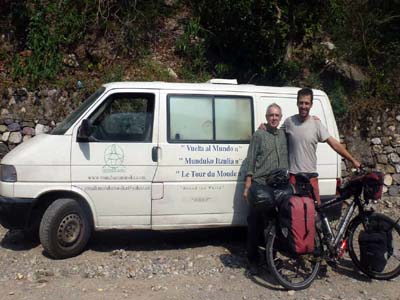
monta la bici que había empaquetado en el sur de la India en una caja
(es bastante peligroso andar en bici por las carreteras Indias) y aunque
se va a quedar unos días en Rishikesh su idea es ir hasta
Ladak por carreteras de montaña poco transitadas, a mas de 5.000 m. de
altura. Yo por mi parte me dispongo a seguir hasta Simla también por
una carretera de montaña, donde las temperaturas rondan los 20 grados:
nada que ver con los más de 40 que he tenido que soportar. |
|
Simla esta a 2.300m. de altitud, y según me voy aproximando, hasta
Ibiletxe se va alegrando pues no tiene que hacer tanto esfuerzo para
enfriar el motor. Es un paisaje de montaña muy bonito, con los pueblos
literalmente colgados de las laderas de los empinados montes, así que no
es de extrañar que al llegar a Simla la circulación sea bastante caótica
debido a las estrechas calles horadadas en la montaña. Simla fue la
capital de verano de los Británicos, y el lugar está lleno de bellos
edificios coloniales e hindúes con bosques y naturaleza en estado puro
rodeando la ciudad. El lugar ha merecido la visita: además da gusto
dormir en Ibiletxe con semejante temperatura!.
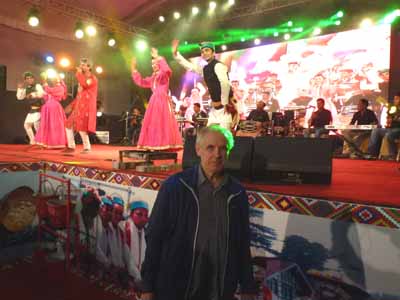
Festival en Simla
El 23 subo hasta los 2.700 m en Narkanda desde donde puedo ver la nevada
cordillera del Himalaya. Aquí conozco a Sunanda, |
|
de Goa, que además de conocer la historia de San
Francisco Javier cuyos restos están en Goa, es amiga de una persona que
tiene una agencia marítima en Mombai, desde donde pensaba embarcar a
Ibiletxe rumbo a Sudamérica. Rápidamente me pongo en contacto con dicha
agencia, y como el precio que me dan parece razonable inicio los
tramites aunque aun tardare unas 3 semanas en llegar a Mombai.
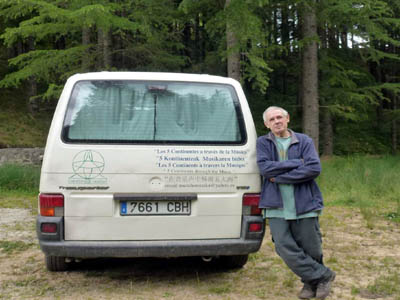
En Nacanda
Me gustaría seguir subiendo con Ibiletxe hasta Srinagar en la
Cachemira India, pero no quiero arriesgar a Ibiletxe. El 2 de Junio
vuelvo a Simla y tengo la suerte de que se acaban de inaugurar los
festivales de verano, con lo que puedo ver algunas representaciones de
música y danza. Pero aunque con mucha |
|
|
| |
pereza debo de volver a la realidad: el calor de New
Delhi.
Me alojo en casa de Harish, amigo de mi hermana y en cuya casa ya había
estado hacia 11 años. Es muy agradable su estupenda comida vegetariana
India, y aun mas agradables las conversaciones especialmente sobre la
India que tengo con el y sus dos hijos: su mujer es también muy atenta
pero no le gusta mucho tomar parte en las conversaciones.
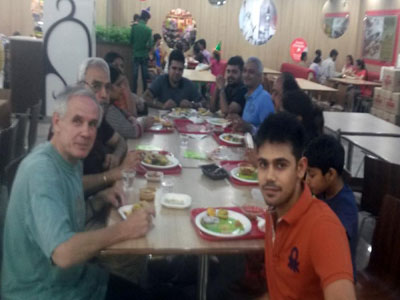
El 7 de Junio parto para Agra, pues me parecería un pecado estar en la
India y no volver a visitar el Taj Mahal. Cuando llego a la ciudad no
me lo puedo creer: el termómetro marca 50 grados, y al bajar de
Ibiletxe sobre mi cae auténtico fuego: no va a ser agradable la visita
en estas condiciones, pero no queda otra. Aparco Ibiletxe en el hostel y
me voy a ver esta maravilla, que |
|
más que un panteón parece un canto a la vida. En el
siglo XVII el emperador Mogol Shah Jahan lo mando construir en recuerdo
de su esposa Multan Mahal que murió después de dar a luz el último de
sus 14 hijos!.
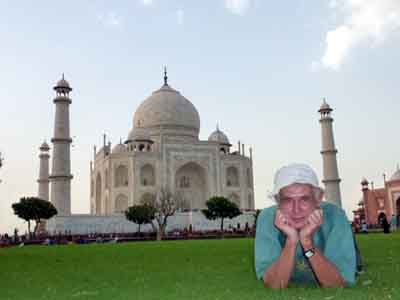
Al día siguiente parto para Mumbai y me resulta difícil de creer que la
carretera llena de baches por la que conduzco es la general que une la
capital política, Delhi, con la capital económica. A unos 300 km de
Mumbai ésta mejora notablemente y ya hasta dicha ciudad va desdoblada.
Pero antes me desvío para ver una de las joyas de la India poco
visitada: Mandu. Fundada en el siglo X, su gran época de esplendor fue
durante los siglos XV/XVI, pero hacia 1700 fue abandonada,
convirtiéndose en una gran ciudad fantasma que ayuda a acrecentar
su misterio y encanto. |
|
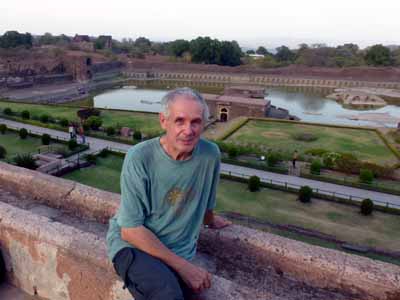
El día 10 entro en Mumbai y enseguida voy a la agencia para tramitar el
embarque. Es la parte que mas detesto de los viajes, pues es un papeleo
que parece no tener fin, y por supuesto es bastante costoso. La ventaja
en esta ocasión es que utilizando el GPS y google maps me puedo
desplazar a todas partes sin problemas: ahorro mucho tiempo
pero....parte de la aventura del viaje se ha ido: no hay que preguntar
nada a nadie!. Mientras, la época de lluvias ha llegado, y de qué manera,
y decido prolongar mi estancia en la India yendo al sur, pues supongo
que las temperaturas habrán bajado. El día 19 introduzco a Ibiletxe en
el contenedor, me despido de ella hasta dentro de casi 2 meses, y el 22
vuelo a Cochin, en el sur de la India. Pensaba haber ido en tren, pero
debido a las fuertes lluvias esta habiendo problemas con |
|
|
| |
ellos, y antes de que Mumbai se convierta en una
ratonera decido salir de ella en avión.
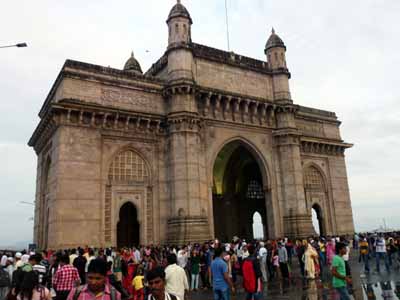
Puerta de la India: Mumbai
Ahora empieza otro viaje, con las dos mochilas a cuestas y los
trenes y los hosteles que tienen que sustituir a Ibiletxe. Todavía hace
calor, pero comparado con los que he pasado es bastante llevadero. De
Kerala es el famoso Katakali, danzas típicas con una simbología
bastante compleja (al menos para los que no somos de allá), y donde los
participantes se maquillan primorosamente, a veces con la ayuda de
otros. Tampoco puedo faltar a un concierto de música karnática típica
del sur de la india, y una actividad a no perder en Cochin es un paseo
en barca por las backwaters, especie de marismas. La barca se mueve
lenta y |
|
pausadamente al ritmo de la pértiga manejada por el
barquero, mientras se adentra por estrechos canales rodeados de una
espesa vegetación tropical. Un espectáculo para la vista de los que no
se 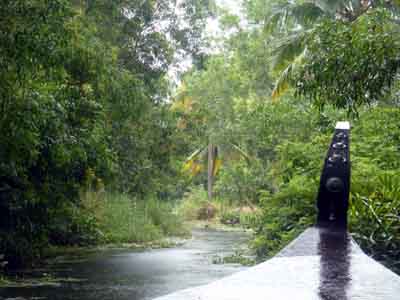
olvidan. Del pasado portugués queda el palacio del siglo XVI bastante
austero por fuera pero que guarda unos bellos murales hindúes, y el
pasado holandés se puede rastrear en la arquitectura de muchos de sus
edificios.
El 27 parto en tren para Hyderabad situada en el centro de la India, y
donde la mayoría de la población es musulmana. De hecho al hacerse la
partición de la península Indostánica entre India y Pakistán a la marcha
de los Británicos en el año 47 sobre bases fundamentalmente religiosas,
el sultán de Hyderabad intentó formar un estado independiente, pero dada
su situación geográfica |
|
fue fácilmente conquistado por la India. Visito el
castillo-palacio de Golkonda que durante bastantes siglos fue la
principal residencia de los sultanes y desde el se divisan las
espléndidas tumbas reales de los Qutb Shahi Por supuesto una visita
obligada es la famosa torre del Charminar en pleno centro de la ciudad
vieja, que a su manera sigue controlando el pulso de la ciudad.
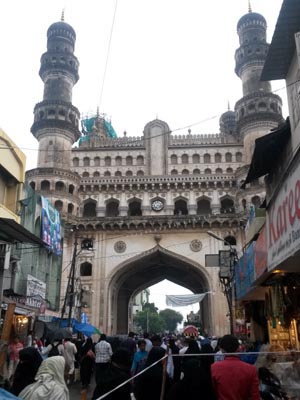
El 2 de
Julio llego a Puri en la costa este, para desde allí visitar el templo
de Konark, que no se puede admirar por dentro pues a |
|
|
| |
principios
del siglo XX el entonces gobernador británico lo mandó llenar de piedras
para que no se derrumbase. De todas formas este templo del siglo XIII es
una de las joyas de la India a no perder, y las ruedas de pìedra
primorosamente labradas a ambos
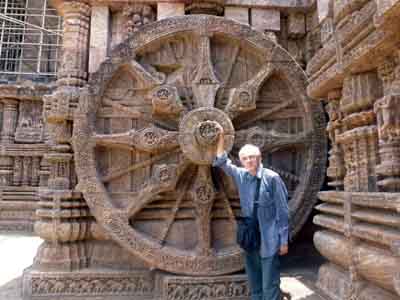
lados del templo simulando un carro, son una de las mejores expresiones
del arte Hindú de aquella época. El 3 llego a Kolkata, y casi sin
descanso el 4 salgo para Patna, pues cerca está Nalanda, que allá por el
siglo VII era una de las más prestigiosas universidades budistas de
Asia, a donde acudían estudiantes de toda ella. Sus ruinas dan fe de su
grandeza y prosperidad pasada, pero el hinduismo hace tiempo que se
implantó en la zona, y no queda ni rastro de la religión budista que
allí se enseñaba. Han sido 10 días de vértigo, durmiendo en los trenes,
chorreando |
|
sudor
debido a los calores que no se acaban de ir, muchas veces con las dos
mochilas encima, así que no es de extrañar que
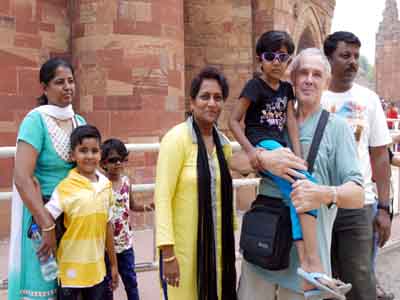
Konark
mientras esperaba el tren tras visitar Nalanda sufriese una lipotimia.
Menos mal que allí estaban conmigo unos estudiantes hindúes recién
conocidos, y para cuando volví a Kolkata todo había pasado
Al final más de 2 meses en la India y la abandono con la misma
sensación de hace 11 años, pensando lo mismo que he escrito al inicio de
esta crónica. Es como si este gobierno y los que le han precedido
hubiesen tirado la toalla respecto a integrar en la sociedad del siglo XXI a esos millones de desheredados que dan la impresión de ser unos
muertos en vida. Son personas que tal |
|
vez debido a sus creencias religiosas se han
resignado a malvivir así, y parecen no esperar nada de la vida, ni
siquiera vivirla. No debe ser tarea sencilla para el gobierno ayudarles
a convertirse en ciudadanos como los demás, (difícilmente se les puede
llamar como tales en las condiciones que viven), pero creo que tal vez
es uno de los mayores desafíos a los que se enfrenta la India.
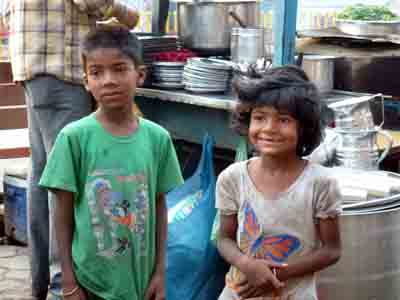 |
|
|
| |
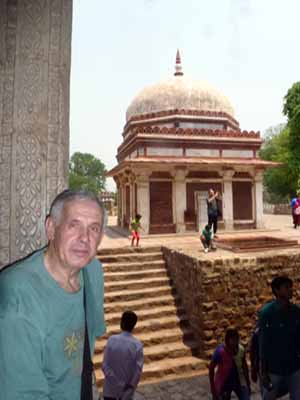
Delhi: qutub minar |
|
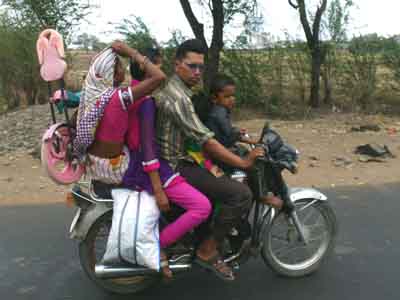
Los 5 de la familia en la moto |
|
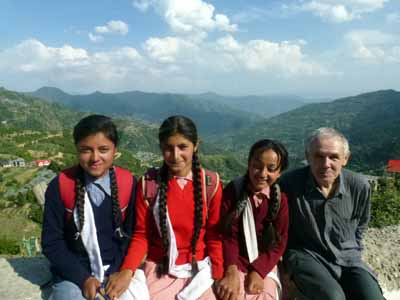
Cerca de Simla |
|
|
| |
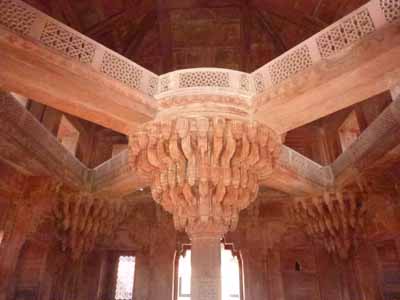
Fatipur |
|
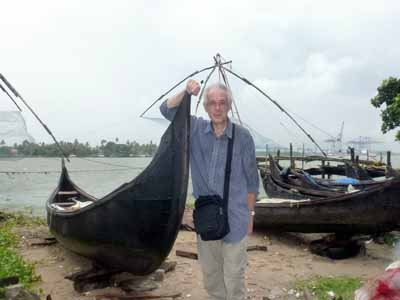
Cochin |
|
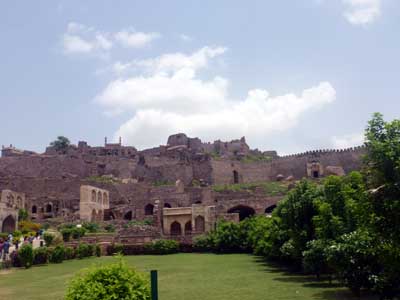
Hyderabad |
|
|
| |
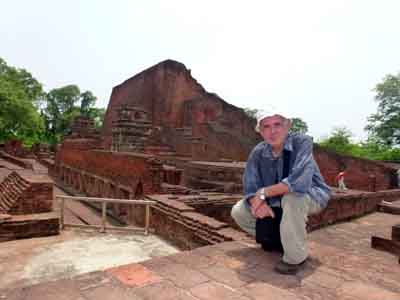
Nalanda |
|
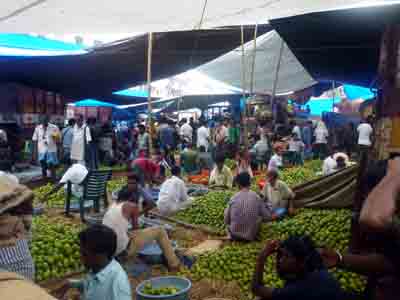
Mercado en Kolkata |
|
|
|
|
|
India
11
years ago when I was about to leave India I wrote: "I must rest from
India for sometime, in order to write later about it, and who knows
maybe even wistfully." India made me hard to digest, so full of
contrasts difficult to explain, because ¿how to explain the beauty and
refinement of the dances and music living at the same time with the
misery and the most absolute acculturation? Or those children cutting a
main road of Gujarat with long sticks in their hands (Ibiletxe took
some shovel from them) and asking in a defiance way for money to eat,
while some in India could buy the moon if they wanted?. India is an
ancient culture that has been able to survive all kinds of invasions,
even survived to the British Empire, but it seems it is difficult for
her to catch up and get into the twenty-first century. Is the birthplace
of the best computer
people in the world, and yet despite being prohibited any
kind of social discrimination, the caste of untouchables is still a
scourge in some rural areas of the country.
On May 11 I entered India through Amristar with the company
of Nassen and his wife. We went to see the famous representation of
closing the border that every day is held jointly by the Indian and
Pakistani guards, and it is curious to see them doing their artistic
maneuvers competing with each other. Indeed is a good watch with their
height of 1.90 m and more, and its impressive bearing.
At dusk we arrived in Amritsar with the obligatory stop at the Golden
Temple, the holiest place of Sikhs, although people come from all
corners of India, is open 24 hours a day and his monks sing their songs
without a rest. |
|
ENGLISH
The
12 of May I arrived to Delhi where I have to drive very carefully, as
generally across the whole India. Truckers are a real danger to the
public because they do not respect anything or anyone: they overtake the
cars when they please and literally take you out of the road. Nassen and
his wife go to an Indian friend's house and I look for a place to
sleep: the heat inside Ibiletxe is unbearable so the next day I decide
to find for a hostel.
Next day Lander, a cyclist from Tolosa that left Euskalerria over a year
ago, comes to the same hostel where we had previously remained, and a
nice meeting occurs the May 14. It seemed difficult to coincide, but the
magic of these trips can make the world becomes small enough for two
travelers. And two days later comes the celebration: ham, cheese, wine,
chorizo that Ibiletxe has kindly transported to this point, and for
dessert Aitor calls from Euskalerria Irratia, Radio Euskadi, to make us
a little interview.
While
I am in Delhi I try to get permission from the Myanmar embassy to go
through this country from India to Thailand, and although the request I
sent four months ago were taken into account, they do not give me any
solution. The country has been closed to vehicles but lately it seems
they are opening their hand, although in a rather random and dropper
way. Maybe if I had stayed longer in Delhi I could have gotten it, but
it's very hot and I want fresh air, so the 18 of May Lander and I go
to the north. That evening we arrived in Rishikesh, next day Lander
assemble the bike previously had packed in southern India in a box (it
is quite dangerous to ride the bike through Indian roads) and after
|
|
being in
Rishikesh for a few days he will go to Ladak over 5.000 m. high by
mountain roads with little traffic!. And for myself I go to Simla also
by a mountain road, where temperature is around 20 degrees: nothing to
compare with the more than 40 degrees I had to suffer sometimes.
Simla is at 2,300m. altitude, and as I'm approaching even Ibiletxe is
cheering because it will not have to work so hard to cool the motor. It
is a very beautiful mountain landscape, with literally perched villages
on the slopes of steep hills, so no wonder that when arriving at Simla
traffic is rather chaotic because of the narrow streets pierced in the
mountains. Simla was the summer capital of the British, and the place is
full of beautiful colonial and Indian buildings, while forests and pure
nature are surrounding the city. The place has
well deserved
a visit and besides is a pleasure to
sleep in Ibiletxe with such temperature.
The
23th climb to 2,700 m in Narkanda from where I can see the snowy
Himalayas. Here I meet Sunanda, from Goa, and in addition to know the
history of San Francisco Javier whose remains are there, has a friend
who have a shipping agency in Mombai, from where I planned to board
Ibiletxe in its way to South America. I quickly get in touch with the
agency, and as the price seems reasonable I start the paperwork even
though it will take about 3 weeks to reach Mombai. I'd like to follow up
with Ibiletxe to Srinagar in Kashmir India, but do not want to risk
her.
On
June 2th, I go back to Simla and I'm lucky because just summer
festivals started, so I can see some performances of |
|
|
| |
music and
dance. But although I am too lazy, I have to return to reality: the
heat of New Delhi.
I
stay at Harish´s house, a friend of my sister, with whom I was 11
years ago. His vegetarian Indian food
is great, and even more pleasant
the conversations especially about India, that I have with him and their
two sons: his wife as well is very nice and polite but does not like
very much to participate in the talks.
June
7 I leave for Agra, because it should be a sin to be in India and
not to visit the Taj Mahal. When I come to town I can not believe it:
the thermometer reads 50 degrees, and when I go out of Ibiletxe
literally fire falls on me: it will not be a pleasant visit in these
conditions, but there is no other way. I park Ibiletxe at the hostel,
and I'm going to see this marvel, that more than a pantheon looks like
a hymn to life. In the seventeenth century Mughal emperor Shah Jahan
ordered to built it in memory of his wife Multan Mahal who died after
giving birth to the last of his 14 children!.
Next
day I head to Mumbai and I find it hard to believe that the road linking
the political capital Delhi and the economic capital is full of
potholes. About 300 km before Mumbai the road improves a lot becoming a
highway. But before arriving I detour to see one of the jewels of India
but little visited: Mandu. Founded in the X century, its great heyday
was during the XV / XVI century, but by 1700 was abandoned, becoming a
ghost town which helps increasing its mystery and beauty.
On
the 10th I arrive in Mumbai and go to the agency that will arrange the
shipment. It is the part I hate most when travelling, because it is a
tape that seems endless, and of course is quite expensive. The advantage
this time is that using the GPS and google maps I can move around
without problems saving a lot of |
|
time but .... part of the adventure of the trip is gone: I do not have
to ask anyone anything. Meanwhile, the rainy season has arrived, and in
a very heavy way, so I decide to extend my stay in India going south,
because I guess temperatures will fall down. On 19th I introduce
Ibiletxe into the container and say goodbye to her since we will not see
in almost two months, and the 22th flight to Cochin in southern India.
My aim was to go by train, but due to heavy rains those are having
problems, and before Mumbai becomes a mousetrap decided to go out of it
by plane.
Now
begins another trip, with both backpacks on me and trains and hostels
will have to replace Ibiletxe. Still is hot, but compared with the past
is quite bearable. From Kerala is the famous Katakali, dances with a
fairly complex symbols (at least for those who are not from there), and
where participants put makeup beautifully, sometimes with the help of
others. I can not fail as well to a karnática concert music typical of
southern India, and an activity not to lose in Cochin is a boat ride on
the so called backwaters. The boat moves slowly and leisurely driven by
the boatman, as we step through narrow channels surrounded by thick
tropical vegetation. A sight not to be forgotten. A portuguese past is
the palace of the XVI century rather austere outside, but inside keeps a
beautiful Indian murals, and the Dutch past can be traced in the
architecture of many buildings.
The
27th I take a train to Hyderabad located in central India,
where most of the population is Muslim. In fact at the time of partition
of the Indian subcontinent between India and Pakistan after the march of
the British in 47 essentially on religious basis, the Sultan of
Hyderabad tried to form an independent state, but given its geographical
location was easily conquered by India . I visit the castle-palace of
Golkonda that for several centuries was the |
|
principal
residence of the sultans and from the splendid royal tombs of the Qutb
Shahi. A must to be seen is the famous tower Charminar in the heart of
the old city, which still in some way controls the pulse of the city.
On
July 2th I come to Puri in the east coast, and from there visit the
Temple of Konark, where is not possible to visit the inside because in
the early twentieth century the then British governor ordered to fill in
with stones in order to prevent the ruin of the place. Anyway this
temple of XIII century is one of the jewels of India not to be lost, and
elaborately carved stone wheels on both sides of the temple simulating a
car are one of the best expressions of Indian art at that time. The 3th
I come to Kolkata, and almost with nonstop the 4th leave for Patna:
Nalanda is very close, and in the seventh century was one of the most
prestigious Buddhist universities there, where it attracted students
from all Asia. Its ruins attest to its past greatness and prosperity,
but Hinduism has long been implanted in the area, and there is no trace
of the Buddhist religion anymore
It
have been 10 days dizziness, sleeping on trains, dripping sweat due to
the heat that stil does not gone, often with two backpacks over, so it
is not surprising that while waiting for the train after visiting
Nalanda I suffered a fainting . Luckily there were with me some new
acquaintances Hindu students, and by the time I returned to Kolkata it
was over.
In
the end they were almost two months in India and I abandon with the same
sense I did 11 years ago, thinking what I wrote at the beginning of this
story. It is as if this government and those who have preceded him had
given up on integrating in the XXI century the millions of poor who give
the impression of being a living dead. They are people who perhaps
because of their religious beliefs |
|
|
| |
have resigned
themselves from having a normal life, and seem to expect nothing, even
living. There seems not to be a simple task for the government to
integrate those citizens like everyone else, (you can hardly call them
as such in living conditions), but I think is the greatest challenge
facing India |
|
|
|
|
|
|
|
|
